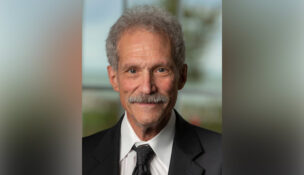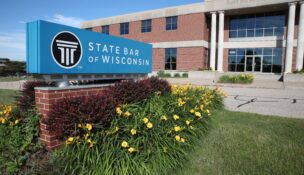CLOSING ARGUMENTS: Was court right to close rules conferences?
By: WISCONSIN LAW JOURNAL STAFF//June 22, 2018//
CLOSING ARGUMENTS: Was court right to close rules conferences?
By: WISCONSIN LAW JOURNAL STAFF//June 22, 2018//

The Wisconsin Supreme Court voted in June 2017 to begin conducting deliberations on the state court system’s formal rules behind closed doors.
To no one’s surprise, the justices’ decision was met immediately with outrage from open-government advocates. But rather than a break from long-standing policy, it was really a return to what had been the court’s practice up until 1999.
Like most courts, Wisconsin’s Supreme Court has always invited the public in to watch litigants argue their positions in particular cases. The court became an outlier in 1999, though, when it chose also to open up its deliberations on administrative matters.
The years following that decision have seen conservative justices regularly winning seats on the state’s high bench. One result of this has been an increasingly apparent division of the justices into two groups, one leaning to the right and the other to the left.
There has also been more and more acrimony and discord. Some of this has spilled out in public during open administrative hearings.
The court’s response, led largely by its conservative wing, has been to curtail the court’s public-meeting requirements. The last step in that direction came with the court’s decision last year to close its rules conferences.
This month, our columnists debate the question: Was the court right to close its rules conferences?
The integrity of judicial review vs. the public’s right to know

Appellate court decisions, like sausages, cease to inspire respect in proportion to how much we know about their creation.
The Wisconsin Supreme Court’s recent return to its long-standing policy of deliberating behind closed doors over administrative matters and the rules it operates under not only brings Wisconsin back in line with every other appellate court in the country but is necessary to protect and preserve the very independence and sanctity of our judiciary. Specious arguments to the contrary all share the fate of further politicization and manipulation of a court that has seen its fair share of both in recent years.
A little history and perspective is important here. Our Supreme Court, like every other appellate court in the country, has always conducted its appellate arguments in public and its deliberations in private. In 1995, the court began the year-long experiment of holding open deliberations on proposed rule changes.
The policy became official the following year. Four years later, the court broke new ground when it also began holding its deliberations on court policy in an open forum. The thoughts, musings, and deliberative interactions of the justices wound up live on the WisconsinEye Public Affairs Network or memorialized on YouTube.
That lasted until 2012, when the court, in a 4-3 partisan vote, decided that a return to discussing administrative policy behind closed doors would save time and improve court relations.
Deliberations over proposed changes to the court’s formal rules, however, were still open to the public. “To sit out here in public and philosophize…is really not the best use of our time,” Justice Pat Roggensack said at the time.
On June 21, 2017, in open conference, the court’s five most conservative justices approved revisions to the Supreme Court’s Internal Operating Procedures, reverting to its original policy of holding its rule-change deliberations behind closed doors. The conservative justices Roggensack, Gableman, Kelly, Ziegler, and Rebecca Bradley, voted to end the public meetings. Liberal Justices Shirley Abrahamson and Ann Walsh Bradley voted against the measure.
The decision to return the court to private deliberations should not come as a surprise to anybody. It had become painfully clear that it was time to end the experiment. The open-deliberation policy harmed consensus building and collegiality among the justices, and the court’s image suffered. Wisconsin remained an outlier and no other court in the country had taken the bait and emulated the practice. Quarreling in public does harm to the Supreme Court as an institution and to the judicial branch of government in general.
Ann Walsh Bradley maintained that the idea behind closed deliberations is “counter-intuitive” and that “The way for us to appear well-behaved is simple—it’s for us to behave well.”
But it appears behaving well was easier said than done for Bradley, who, during the very public open conference held on June 21, stood over Justice Gableman’s shoulder and angrily tried to grab memos he was reading from his hands. This prompted a public reminder from Gableman of an incident in 2011 in which Justice David Prosser acted in self-defense by allegedly placing his hands on Bradley’s neck. Suffice it to say, consensus-building and collegiality were not on display in the video, which went viral.
Of the three branches of government, the judicial branch is necessarily the most clandestine. Publicity interferes with important aspects of how justice is dispensed. It is easy—even lazy—to simply assume that because “greater transparency” sounds good, it should be the rule. If pre-decision deliberations—when the justices’ tentative thoughts and candid theories are tested and debated with colleagues—are aired on television, their thoughts and comments become material in future litigation and form the framework for future appellate arguments. Public deliberations lead to judges reading from prepared scripts and choosing their words and expressions surgically, diminishing the quality of debate to the detriment of decision-making and the advancement of legal theory.
The secrecy of deliberations is as important for appellate courts as it is for juries. Both serve an intermediary role and must be independent of the state, of the parties and of the community itself.
Even in an open society, confidentiality is sometimes necessary for a full airing of the issues. Justices need the freedom to try out policy positions and reveal their candid uncertainties—both of which are unlikely to occur if they might end up on the evening news.
Open deliberations stifle candor and inject a new pathology into a hallowed process. They provide opportunity and ammunition for political operatives and special-interest groups who rely on the Supreme Court—as opposed to the Legislature—to carry out their agenda. Courts would have to wrestle with whether to allow these public deliberations to affect other decisions, raising many of the same issues involved in debates over the precedential value of unpublished opinions. Justices deliberating in public behave, speak, and think strategically.
The inherent value of private deliberations is lost in an open forum, and politics is always waiting at the gate. Wisconsin is one of fourteen states that hold “non-partisan” elections for their Supreme Court justices, but recent contests (including Justice Prosser’s recall) have been anything but “non-partisan,” with both sides receiving money from well-financed special interests outside Wisconsin. Politics is a circus with better actors; private deliberation allows justices to be judges instead of politicians.
Opponents of private judicial deliberations have called it a “blow to representative government,” which is a peculiar contention since the judiciary isn’t composed of “representatives” and every other state does it that way. Judges represent only equal justice under the law. The Wisconsin Supreme Court does not need a chaperone while it internally debates its policies and rules. Instead of allowing itself to become a laboratory for political operatives, the court should remain steadfast to the hallowed judicial procedures honored by every other court in the country.
Gary L. Wickert is an insurance trial lawyer and partner at the law firm of Matthiesen, Wickert & Lehrer, S.C.
A case for reopening the rules conferences to the public

For reasons both philosophical and practical, reopening the Wisconsin Supreme Court’s rule-making conferences to the public would better serve the interests of the public, the bar, and the bench.
The most obvious reason for a return to greater transparency is that it is consistent with the ideals the court has long espoused. The court has frequently touted Wisconsin’s tradition of openness when considering, on its docket, cases that present issues of transparency in other branches of government.
Because of this distinction, it is irrelevant that the Wisconsin Supreme Court previously had little company among other state courts in holding open rules conferences. Wisconsin has long been a leader, not a follower, in matters of open government.
Moreover, legal analysts have noted that it is especially appropriate for courts to allow public access to their rule-making processes because when they adopt rules, courts act in a legislative, rather than in an adjudicative, capacity.
As former United States District Court Judge Jack B. Weinstein noted in his influential 1977 publication, “Reform of Court Rule-Making Procedures,” it is “healthy” to recognize the need to make judicial rule-making a public process. “When courts assume a legislative role, they should also assume the restraints that accompany that role,” he wrote. “Public deliberations are a basic safeguard to insure a legislative process that is fair and informed.”
Weinstein’s work has been widely cited. It is referenced, for instance, in the notes published by the federal Advisory Committee on the Rules of Civil Procedure.
In addition, despite separation-of-powers questions that could be debated, the Legislature has sometimes enacted rules that affect procedure and process in the courts. In situations in which either the Legislature or the Supreme Court could set a rule, the lack of public access to the process may affect whether the court is seen as the most appropriate institution to do so.
When the court’s rule-making process is less transparent than that of the Legislature, the Legislature may contend that its process is superior because it is more transparent.
Judge Weinstein described similar reactions to Congressional involvement in the enactment of updated federal rules governing evidence, noting that the legislative procedures ensured “a full ventilation of the issues.”
He added that the public hearings held in connection with revisions to the rules of federal criminal procedure provided them “an aura of legitimacy that they theretofore might have lacked.”
Opening the court’s rules conferences also provides greater opportunity for access to information that can help resolve questions regarding rules’ interpretation. Although the basic intent for promulgating a rule may be disclosed through notices issued before enactment and through contemporaneous memoranda that outline significant considerations, some information will inevitably be lost in translation through the exercise of summarizing the more complete discussion that occurs in conferences.
Allowing the public to attend rules conferences also boosts public confidence in the integrity of the court’s process and in the resulting rules by disproving, in advance, suspicions that rules may be adopted for improper reasons, such as to favor special interests.
But the most compelling reason to reopen public access to rules conferences is that it provides an opportunity for the court to model not only institutional transparency, but the lost art of civility.
Examples of incivility in political debate have become legion, and scores of samples of poor public discourse populate the online comments that frequently accompany news articles.
Lawyers and judges are uniquely equipped to demonstrate how those who are on opposing sides of serious and contentious issues can articulate competing positions in a respectful and courteous manner, even in cases in which they vehemently disagree with one another.
Archived videos of previous public rules conferences already provide examples in which the Supreme Court considered and discussed – with civility and respect – various issues.
Against these many reasons favoring public access to the court’s rule-making process, few, if any, valid reasons support closing them. A frequently cited reason for denying public access in various contexts is the assertion that closed meetings and deliberations somehow promote more “frank” or “candid” discussions. Reduced to plain terms, this is an assertion that behind closed doors, decision-makers can more readily express sentiments that they would not want to share in public.
But the rejoinder to that claim is that there is likely little, if any, value in encouraging statements that are not suited for public consumption. And there is reason to be concerned when reasons that cannot be publicly stated could be given serious consideration during the processes that set the rules for the conduct of public institutions.
Particularly with respect to the rules that will govern the process that members of the public must follow when they seek redress in our state’s court systems, any considerations that are not worthy of being stated in public are likely not worth stating at all. To the contrary, those sentiments almost certainly should not even enter into decision-making.
Previously recorded examples of public rules conferences demonstrate that our Supreme Court can provide an inspiring model for the manner in which difficult questions can be resolved with dignity and grace. Now more than ever, we need the court to lead by example.
For this reason and many others, the bench, bar and the public would all be benefited by the return of open rules conferences in the Supreme Court.
April Rockstead Barker is a shareholder in the firm Schott, Bublitz & Engel, s.c., in Waukesha. She specializes in civil litigation in state and federal courts, and she also frequently represents those seeking access to public records. She is a co-vice president of the Wisconsin Freedom of Information Council.
Legal News
- Wisconsin joins Feds, dozens of states to hold airlines accountable for bad behavior
- Trump ahead of Biden in new Marquette poll
- Bankruptcy court approves Milwaukee Marriott Downtown ‘business as usual’ motion
- New Crime Gun Intelligence Center to launch in Chicago
- Arrest warrant proposed for Minocqua Brewing owner who filed Lawsuit against Town of Minocqua
- Wisconsin Supreme Court justices question how much power Legislature should have
- Reinhart named the 2024 Wisconsin law firm of the year by benchmark litigation
- Milwaukee’s Common Council now has the most African Americans, women and openly LGBTQ members ever
- Office of School Safety Provides Behavioral and Threat Assessment Management Training Ahead of 25th Anniversary of Columbine Shooting
- Wisconsin Supreme Court to hear arguments in Democratic governor’s suit against GOP-led Legislature
- Lawsuit asks Wisconsin Supreme Court to strike down governor’s 400-year veto
- Wisconsin man pleads not guilty to neglect in disappearance of boy
WLJ People
- Power 30 Personal Injury Attorneys – Russell Nicolet
- Power 30 Personal Injury Attorneys – Benjamin Nicolet
- Power 30 Personal Injury Attorneys – Dustin T. Woehl
- Power 30 Personal Injury Attorneys – Katherine Metzger
- Power 30 Personal Injury Attorneys – Joseph Ryan
- Power 30 Personal Injury Attorneys – James M. Ryan
- Power 30 Personal Injury Attorneys – Dana Wachs
- Power 30 Personal Injury Attorneys – Mark L. Thomsen
- Power 30 Personal Injury Attorneys – Matthew Lein
- Power 30 Personal Injury Attorneys – Jeffrey A. Pitman
- Power 30 Personal Injury Attorneys – William Pemberton
- Power 30 Personal Injury Attorneys – Howard S. Sicula











